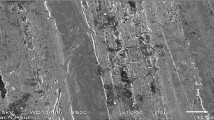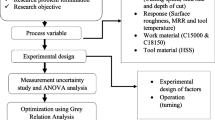Abstract
Machinability aspect is of considerable importance for efficient process planning in manufacturing. Machinability of work materials is an imperative aspect which may affect the different manufacturing phases including product design, process planning and machining operation. Machinability of engineering materials may be evaluated in terms of process output variables like surface roughness (SR), material removal rate, cutting forces etc. In this paper, graph theoretic approach is proposed to assess the performance of die steel H-11 using titanium coated carbide cutter, together with spiral type cutter path strategy. SR is considered as machinability attribute to evaluate the effect of several factors and sub-factors. Factors affecting machinability and their interactions are analyzed by developing a mathematical model using digraph and matrix method. Permanent function is obtained from the matrix model and the function value aids in quantifying the influence of considered factors on machinability. Factors affecting SR are grouped into five factors namely work-piece, tool coating, tool geometry, cutter path strategy and machine tool. The results reveals that machine tool has the highest index value and hence the most influencing factor and feed rate is the most significant sub-factor influencing SR of H-11 using titanium coated carbide cutter on CNC Milling.










Similar content being viewed by others
References
Altintas Y (1994) Direct adaptive control of end milling process. Int J Mach Tools Manuf 34:461–472
Deo N (2000) Graph theory with application to engineering and Computer Science. Prentice Hall, New Delhi
Dev N, Samsher, Kachhwaha SS, Attri R (2013) GTA-based framework for evaluating the role of design parameters in cogeneration cycle power plant efficiency. Ain Shams Eng J 4:273–284
Dev N, Samsher, Kachhwaha SS, Attri R (2014a) Development of reliability index for combined cycle power plant using graph theoretic approach. Ain Shams Eng J 5:193–203
Dev N, Samsher, Kachhwaha SS, Attri R (2014b) Development of reliability index for combined cycle power plant using graph theoretic approach. Int J Syst Assur Eng Manag. doi:10.1007/s13198-014-0235-4
Devillez A, Schneider F, Dominiak S (2007) Cutting forces and wear in dry machining of Inconel 718 with coated carbide tools. Wear 262:931–942
Ding TC, Zhang S, Wang YW, Zhu XL (2010) Empirical models and optimal cutting parameters for cutting forces and surface roughness in hard milling of AISI H13 steel. Int J Adv Manuf Technol 51:45–55
Dweiri F, Al-Jarrah M, Al-Wedyan H (2003) Fuzzy surface roughness modeling of CNC down milling of Alumic-79. JOMPT 133:266–275
Ezugwu EO (2005) Key improvements in the machining of difficult-to-cut aerospace superalloys. Int J Mach Tool Manuf 45(12/13):1353–1367
Gologlu C, Sakarya N (2008) Effect of cutter path strategies of surface roughness of pocket milling of 1.2738 steel based on Taguchi method. JOMPT 206:7–15
Grover S, Agarwal VP, Khan IA (2004) A digraph approach to TQM evaluation in an industry. Int J Prod Res 42(19):4031–4053
Huang W, Hu Y, Cai L (2012) An effective hybrid graph and genetic algorithm approach to process planning optimization for prismatic parts. Int J Adv Manuf Technol 62:1219–1232
Jangra K, Grover S, Chan TS (2002) Digraph and matrix method to evaluate the machinability of tungsten carbide composite with wire EDM. Int J Adv Manuf Technol 56:959–974
Jangra K, Grover S, Aggarwal A (2010) Digraph and matrix method for the performance evaluation of carbide compacting die manufactured by wire EDM. Int J Adv Manuf Technol. doi:10.1007/s00170-010-2956-0
Jindal PC, Santhanam AT, Shuster FA (1999) Performance of PVD TiN, TiCN and TiAlN coated cemented carbide tools in turning. Int J Refract Met Hard Mater 17:163–170
Joseph R.D, Tool Materials, 1995, P.138
Kadirgama K, Hamdi M, Benyounis KY (2007) Prediction of cutting force in end-milling operation of modified AISI P20 tool steel. JOMPT 182:241–247
Lou MS, Chen JC, Caleb M (1999) Surface roughness prediction technique for CNC end milling. J Ind Technol 15:1–6
Mohan M, Gandhi OP, Agrawal VP (2003) Systems modelling of a coal-based steam power plant. Proc Inst Mech Eng 217:259–276
Oktem H, Kurtaran H (2005) Application of RSM in optimization of cutting conditions for surface roughness. JOMPT 170:11–16
Rao RV, Gandhi OP (2002) Digraph and matrix methods for the machinability evaluation of work materials. Int J Mach Tools Manuf 42:321–330
Rao RV, Padmanabhan KK (2006) Selection, identification and comparison of industrial robots using digraph and matrix methods. Robot Comput Integr Manuf 22:373–383
Siller HR, Vila C, Rodríguez CA, Abellán JV (2009) Study of face milling of hardened AISI D3 steel with a special design of carbide tools. Int J Adv Manuf Technol 40:12–25
Toh CK (2006) Cutter path orientations when high-speed finish milling inclined hardened steel. Int J Adv Manuf Technol 27:473–480
Trent EM (1989) Metal Cutting, 2nd edn. Butterworths, Oxford, p 172
Tsai YH, Chen JC (1999) In process surface recognition system based on neural networks in end milling cutting operation. Int J Mach Tools Manuf 39:583–605
Tzeng YF (2007) A hybrid approach to optimize multiple performance characteristics of high speed computerized numerical control milling tool steels. Mater Des 28:36–46
Venkatasamy R, Agarwal VP (1995) System and structure analysis of an automobile vehicle—a graph theoretic approach. Int J Veh Des 16:477–505
Zhang JZ, Chen JC, Kirby ED (2007) Surface roughness optimization in an end milling operation using Taguchi design method. JOMPT 184:233–239
Author information
Authors and Affiliations
Corresponding author
Rights and permissions
About this article
Cite this article
Chahal, M., Singh, V. & Garg, R. Machinability evaluation of dies steel H-11 with CNC Milling using digraph and matrix method. Int J Syst Assur Eng Manag 8 (Suppl 1), 169–179 (2017). https://doi.org/10.1007/s13198-014-0305-7
Received:
Revised:
Published:
Issue Date:
DOI: https://doi.org/10.1007/s13198-014-0305-7




